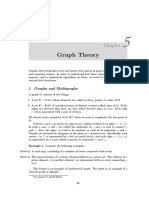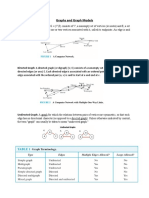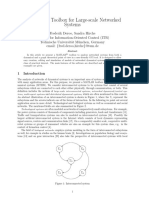Graph Theory: Introduction
Graph Theory: Introduction
Uploaded by
Minani Jean BaptisteCopyright:
Available Formats
Graph Theory: Introduction
Graph Theory: Introduction
Uploaded by
Minani Jean BaptisteOriginal Description:
Original Title
Copyright
Available Formats
Share this document
Did you find this document useful?
Is this content inappropriate?
Copyright:
Available Formats
Graph Theory: Introduction
Graph Theory: Introduction
Uploaded by
Minani Jean BaptisteCopyright:
Available Formats
GRAPH THEORY: INTRODUCTION
DEFINITION 1: A graph G consists of two nite sets: a set V (G) of vertices and a set E (G) of edges, where each edge is associated with a set consisting of either one or two vertices called its endpoints. The correspondence from edges to endpoints is called the edge-endpoint function. An edge with just one endpoint is called a loop, and two distinct edges with the same set of endpoints are said to be parallel. An edge is said to connect its endpoints; two vertices that are connected by an edge are called adjacent; and a vertex that is an endpoint of a loop is said to be adjacent to itself. An edge is said to be incident on each of its endpoints, and two edges incident on the same endpoint are called adjacent. A vertex on which no edges are incident is called isolated. A graph with no vertices is called empty, and one with at least one vertex is called nonempty. EXAMPLE: Consider the following graph:
(a) Write the vertex set and the edge set, and give a table showing the edge-endpoint function; (b) Find all that are incident on v1 , all vertices that are adjacent to v1 , all edges that are adjacent to e1 , all loops, all edges, all vertices that are adjacent to themselves, all isolated vertices. Solution: (a) We have: vertex set = {v1 , v2 , v3 , v4 , v5 , v6 } edge set = {e1 , e2 , e3 , e4 , e5 , e6 , e7 } edge-endpoint function : Edges e1 e2 e3 e4 e5 e6 e7 Endpoints {v1 , v2 } {v1 , v3 } {v1 , v3 } {v2 , v3 } {v5 , v6 } {v 5 } {v 6 }
(b) We have:
, and and
are incident on v1 .
are adjacent to v1 . are adjacent to e1 .
, and and and and
are loops. are parallel. are adjacent to themselves.
is an isolated vertex. DEFINITION 2: A simple graph is a graph that does not have any loops or parallel edges. In a simple graph, an edge with endpoints v and w is denoted {v, w}. EXAMPLE: Draw all simple graphs with the four vertices {u, v, w, x} and two edges, one of which is {u, v }. Solution: There are 5 such graphs:
DEFINITION 3: A complete graph on n vertices, denoted Kn , is a simple graph with n vertices v1 , v2 , . . . , vn whose set of edges contains exactly one edge for each pair of distinct vertices. EXAMPLE: Draw the complete graphs K2 , K3 , K4 , and K5 . Solution:
DEFINITION 4: A complete bipartite graph on (m, n) vertices, denoted Km,n , is a simple graph with vertices v1 , v2 , . . . , vm and w1 , w2 , . . . , wn that satises the following properties: for all i, k = 1, 2, . . . , m and all j, l = 1, 2, . . . , n, 1. There is an edge from each vertex vi to each vertex wj ; 2. There is not an edge from any vertex vi to any other vertex vk ; 3. There is not an edge from any vertex wj to any other vertex wl . EXAMPLE: Draw the bipartite graphs K3,2 and K3,3 . Solution:
DEFINITION 5: A graph H is said to be a subgraph of a graph G if, and only if, every vertex in H is also a vertex in G, every edge in H is also an edge in G, and every edge in H has the same endpoints as in G. EXAMPLE: List all nonempty subgraphs of the graph G with vertex set {v1 , v2 } and edge set {e1 , e2 , e3 }, where the endpoints of e1 are v1 and v2 , the endpoints of e2 are v1 and v2 , and e3 is a loop at v1 . Solution: We rst draw the graph:
This graph has 11 subgraphs:
DEFINITION 6: Let G be a graph and v a vertex of G. The degree of v, denoted deg(v ), equals the number of edges that are incident on v, with an edge that is a loop counted twice. The total degree of G is the sum of the degrees of all the vertices of G. EXAMPLE: Find the degree of each vertex of the graph G shown below. Then nd the total degree of G.
Solution:
THEOREM: If G is any graph, then the sum of the degrees of all the vertices of G equals twice the number of edges of G. COROLLARY 1: The total degree of a graph is even. EXAMPLE: Draw a graph with the specied properties or show that no such graph exists. (a) Graph with four vertices of degrees 1, 1, 2, and 3. (b) Graph with four vertices of degrees 1, 1, 3, and 3. (c) Simple graph with four vertices of degrees 1, 1, 3, and 3. Solution:
COROLLARY 2: In any graph there are an even number of vertices of odd degree. PROBLEM: Is it possible in a group of 9 people for each to shake hands with exactly 5 other persons? Solution: The answer is no. In fact, imagine a graph in which each of the 9 people is represented by a dot and two dots are joined by an edge if, and only if, the people they represent shook hands. Suppose each of the people shook hands with exactly 5 others. Then we have an odd number (nine) vertices of odd degree. This contradicts Corollary 2.
You might also like
- KenGen ICT PolicyDocument24 pagesKenGen ICT PolicyMinani Jean Baptiste100% (1)
- Bms College of Engineering, Bangalore-19 Department of MathematicsDocument13 pagesBms College of Engineering, Bangalore-19 Department of MathematicsDarshan .BNo ratings yet
- Discrete Chapter3Document40 pagesDiscrete Chapter3DesyilalNo ratings yet
- Discrete Math 6Document47 pagesDiscrete Math 6plabonrahman.meNo ratings yet
- Topic 5 - Graph and Trees TheoryDocument92 pagesTopic 5 - Graph and Trees TheoryhawarieslabNo ratings yet
- Week 11 - GraphsDocument11 pagesWeek 11 - GraphsEmmanuel GuillermoNo ratings yet
- EContent 11 2023 01 30 08 32 46 UNIT4GRAPHANDTREEpdf 2022 12 27 10 42 44Document31 pagesEContent 11 2023 01 30 08 32 46 UNIT4GRAPHANDTREEpdf 2022 12 27 10 42 44bsettle1003No ratings yet
- CS6702 GRAPH THEORY AND APPLICATIONS UNIT I INTRODUCTIONDocument25 pagesCS6702 GRAPH THEORY AND APPLICATIONS UNIT I INTRODUCTIONsathvik aNo ratings yet
- AT ChapIDocument48 pagesAT ChapIvigneshwaranbeNo ratings yet
- Unit VDocument74 pagesUnit VvishnuNo ratings yet
- Unit VDocument77 pagesUnit VDarsh RawatNo ratings yet
- Graph TheoryDocument41 pagesGraph Theoryleonelbulawan485No ratings yet
- M4 Module2Document125 pagesM4 Module2Gayathri S RNo ratings yet
- Introduction To Graph TheoryDocument51 pagesIntroduction To Graph TheoryDwi MaryonoNo ratings yet
- Unit 5Document14 pagesUnit 5phanishekarreddy116No ratings yet
- GraphsDocument156 pagesGraphsVishal GaurNo ratings yet
- Unit 5Document77 pagesUnit 5TANISHA KAPOOR (RA2011027010056)No ratings yet
- Let Us Switch To A New Topic:: Graphs Graph TheoryDocument27 pagesLet Us Switch To A New Topic:: Graphs Graph TheoryAfiat Khan TahsinNo ratings yet
- Basic Graph Theory PDFDocument28 pagesBasic Graph Theory PDFManojKumarSinghNo ratings yet
- Ppt-Unit 5 - 18mab302t-Graph TheoryDocument72 pagesPpt-Unit 5 - 18mab302t-Graph TheoryRishu RajNo ratings yet
- Graph Terminology PDFDocument9 pagesGraph Terminology PDFPeter BandaNo ratings yet
- Cha5 Graph TheoryDocument10 pagesCha5 Graph Theoryham.karimNo ratings yet
- Unit Vi GraphDocument68 pagesUnit Vi Graphdnyaneshwarpande60No ratings yet
- Topic 5 Lecture Notes (Gardiner)Document74 pagesTopic 5 Lecture Notes (Gardiner)tonyho2003No ratings yet
- Discreet StructuresDocument118 pagesDiscreet StructuresRishabh KumarNo ratings yet
- Module NotesDocument19 pagesModule Notesg6xwsg27jfNo ratings yet
- Discrete Math Week 15 December 6, 2012: ShimizuDocument20 pagesDiscrete Math Week 15 December 6, 2012: Shimizuundo4worldNo ratings yet
- DS Leceture 18Document9 pagesDS Leceture 18mtalhamalik998No ratings yet
- Graphs and Graph ModelsDocument5 pagesGraphs and Graph ModelsSajjad ShamimNo ratings yet
- (Graph Theory) : Discrete Structure Tribhuvan University Kathmandu, NepalDocument44 pages(Graph Theory) : Discrete Structure Tribhuvan University Kathmandu, NepalSuman Thapa MagarNo ratings yet
- Unit 5 Graphs & Tree Lecture Notes 2024-25Document28 pagesUnit 5 Graphs & Tree Lecture Notes 2024-25fuuny cocNo ratings yet
- Unit 4 Graph Theory: Prepared By: Ramesh RimalDocument129 pagesUnit 4 Graph Theory: Prepared By: Ramesh RimalramnathNo ratings yet
- Notes 943 Unit4 GraphsDocument58 pagesNotes 943 Unit4 Graphskewep39969No ratings yet
- Lecture 14 - DMDocument6 pagesLecture 14 - DMMerei MuratovNo ratings yet
- Chapter 4 (Graph Theory Edited)Document18 pagesChapter 4 (Graph Theory Edited)Babal YepaNo ratings yet
- Discrete Math - Graph - TreeDocument47 pagesDiscrete Math - Graph - TreeSamratNo ratings yet
- Unit 1Document20 pagesUnit 1G Bharat TajNo ratings yet
- Graph Theory and ApplicationsDocument45 pagesGraph Theory and Applicationssubramanyam62No ratings yet
- Graph 032001Document16 pagesGraph 032001Hulk ManNo ratings yet
- Graph Theory NotesDocument49 pagesGraph Theory NotesShyupomen UzNo ratings yet
- Unit-2.1Document69 pagesUnit-2.1riddhichaskar750No ratings yet
- Graph Terminology and Special Types of GraphsDocument29 pagesGraph Terminology and Special Types of Graphsmaligaya evelynNo ratings yet
- DM GraphsDocument6 pagesDM Graphsanon-552375No ratings yet
- DSLec 13Document28 pagesDSLec 13Hamayon WazirNo ratings yet
- DS Lecture 22 (Intro To Graphs)Document22 pagesDS Lecture 22 (Intro To Graphs)Malika DiaNo ratings yet
- 7 GraphsDocument39 pages7 GraphsSomaiah SulaimanNo ratings yet
- Graph Theory Notes by Vadim LozinDocument73 pagesGraph Theory Notes by Vadim LozinDmitry Krylov100% (1)
- Graph Theory Basics For INMODocument10 pagesGraph Theory Basics For INMOB V KarthikeyaNo ratings yet
- Graph Theory Answer KeyDocument55 pagesGraph Theory Answer KeyNeeraj SinghNo ratings yet
- The Mathematics of GraphsDocument51 pagesThe Mathematics of GraphsJebbrys LargoNo ratings yet
- Graph Theory NotesDocument53 pagesGraph Theory Notesmazhar10325100% (1)
- UNIT-6 DMDocument82 pagesUNIT-6 DMsamharisson1986No ratings yet
- graphs and gates exam editionDocument15 pagesgraphs and gates exam editionimmyimmaculate296No ratings yet
- Graph theory Introduction L 1.pdfDocument18 pagesGraph theory Introduction L 1.pdfbubunadefNo ratings yet
- EContent 11 2023 02 13 08 51 50 UNIT6PlanarandNonplanargraphpdf 2023 02 07 09 19 28Document16 pagesEContent 11 2023 02 13 08 51 50 UNIT6PlanarandNonplanargraphpdf 2023 02 07 09 19 28bsettle1003No ratings yet
- Question BankDocument22 pagesQuestion Bankshalika booma100% (3)
- Lecture On Graph Theory 1Document31 pagesLecture On Graph Theory 1gandlachandana12No ratings yet
- 9.0 Graphs Full SetDocument63 pages9.0 Graphs Full SetFaiz RamliNo ratings yet
- And Finite Number of EdgesDocument10 pagesAnd Finite Number of EdgesKavita RahaneNo ratings yet
- CH05: Designing The System Designing The System (Continue) : What Is Design? Conceptual and Technical DesignsDocument12 pagesCH05: Designing The System Designing The System (Continue) : What Is Design? Conceptual and Technical DesignsMinani Jean BaptisteNo ratings yet
- Deliverable 2Document2 pagesDeliverable 2Minani Jean BaptisteNo ratings yet
- Lab #1: Arrays, Pointers and Structures Question #1: ArraysDocument1 pageLab #1: Arrays, Pointers and Structures Question #1: ArraysMinani Jean BaptisteNo ratings yet
- F 4 Internet UseDocument3 pagesF 4 Internet UseMinani Jean BaptisteNo ratings yet
- Graph Notes by Kapil YadavDocument17 pagesGraph Notes by Kapil YadavAditya KumarNo ratings yet
- Strongly Connected ComponentDocument22 pagesStrongly Connected ComponentJhaideenar AdaoNo ratings yet
- Cs2251 - Design and Analysis of Algorithms 2 Marks Questions With AnswersDocument27 pagesCs2251 - Design and Analysis of Algorithms 2 Marks Questions With AnswersMohan MohanbagavathiNo ratings yet
- Design and Analysis of Algorithms CO 401: Ash Mohammad AbbasDocument18 pagesDesign and Analysis of Algorithms CO 401: Ash Mohammad AbbasMohd Nafees AnsariNo ratings yet
- Binary Trees, Binary Search Tree, GraphDocument10 pagesBinary Trees, Binary Search Tree, GraphAkhtar NawazNo ratings yet
- Minimum Spanning Tree Algorithm: Aor Case Study AssignmentDocument8 pagesMinimum Spanning Tree Algorithm: Aor Case Study AssignmentRupam BiswasNo ratings yet
- Cs6702 Graph Theory and Applications Notes PDF Book - CompressedDocument153 pagesCs6702 Graph Theory and Applications Notes PDF Book - CompressedThanga Abirami100% (2)
- Reynolds-Feighan and Vega: Structural Centrality Relations in The Global Air Transport SystemDocument9 pagesReynolds-Feighan and Vega: Structural Centrality Relations in The Global Air Transport SystemPhan Thành TrungNo ratings yet
- Ivy For Grasshopper Manual: 1. Meshgraph CreationDocument21 pagesIvy For Grasshopper Manual: 1. Meshgraph CreationAravind AkashNo ratings yet
- UNIT-3: Chromatic NumberDocument35 pagesUNIT-3: Chromatic NumberCh VynaNo ratings yet
- MT131 Tutorial - 7 GraphsDocument55 pagesMT131 Tutorial - 7 Graphsamr alzaktaNo ratings yet
- Harmonic Mean Labelling of Subdivision and Related Graphs: V X V F U FDocument9 pagesHarmonic Mean Labelling of Subdivision and Related Graphs: V X V F U FRahul SharmaNo ratings yet
- Infinite Resistor MeshDocument13 pagesInfinite Resistor MeshGideonNo ratings yet
- HW1 SolDocument3 pagesHW1 SolharshNo ratings yet
- Mathematics Research For The Beginning Student Goldwyn, Ganzell & Wootton Vol-1Document323 pagesMathematics Research For The Beginning Student Goldwyn, Ganzell & Wootton Vol-1cesar394No ratings yet
- Informed Search Strategies: J. Felicia LilianDocument24 pagesInformed Search Strategies: J. Felicia LilianAbhinav PanchumarthiNo ratings yet
- DSGT Tech KnowledgeDocument167 pagesDSGT Tech Knowledgekanchisudhanwa7100% (2)
- VLSI Physical Design Automation: Lecture 9. Introduction To Routing Global Routing (I)Document51 pagesVLSI Physical Design Automation: Lecture 9. Introduction To Routing Global Routing (I)bhawnaNo ratings yet
- 2 - Network ModelsDocument8 pages2 - Network ModelsAnn Coleen KayNo ratings yet
- MatroidDocument18 pagesMatroidjoseph676No ratings yet
- DAA ADA Viva QuestionsDocument13 pagesDAA ADA Viva QuestionsAbhishek Manjunath71% (34)
- AI Quiz 1 SolutionsDocument5 pagesAI Quiz 1 Solutionsfunnyclups413No ratings yet
- Introduction To Graph TheoryDocument47 pagesIntroduction To Graph TheoryJan Lemuel T. Gonzalvo100% (2)
- Ejemplo de Diagrama Pert en ExcelDocument7 pagesEjemplo de Diagrama Pert en Excelhector eduardo perez carhuapomaNo ratings yet
- CS 213 2022Document20 pagesCS 213 2022Ravi VedicNo ratings yet
- Simple Graphs: Coloring: Flights Need Gates, But Times Overlap. Gates Needed?Document7 pagesSimple Graphs: Coloring: Flights Need Gates, But Times Overlap. Gates Needed?DivijNo ratings yet
- A MATLAB Toolbox For Large-Scale Networked SystemsDocument12 pagesA MATLAB Toolbox For Large-Scale Networked SystemsKawthar ZaidanNo ratings yet
- Buet Admission About TreeDocument26 pagesBuet Admission About TreeOporajitaNo ratings yet
- Chapter-Wise Suggestion Paper: M201 MathematicsDocument6 pagesChapter-Wise Suggestion Paper: M201 MathematicsSoumodip ChakrabortyNo ratings yet
- Cse 418Document3 pagesCse 418Kislay SinghNo ratings yet






























































































